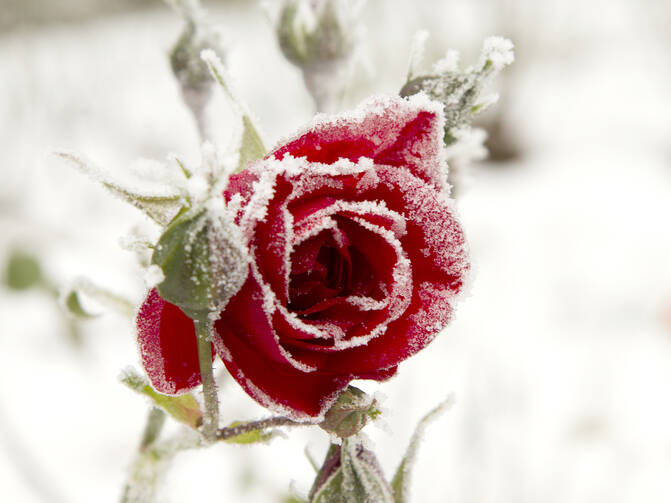The rapper Tupac Shakur frequently wrote poetry that was not accompanied by music. Perhaps his best-known poem of this sort is “The Rose That Grew From the Concrete”:
Did you hear about the rose that grew
from a crack in the concrete?
Proving nature’s law is wrong it
learned to walk without having feet.
Shakur’s juxtaposition of a beautiful rose emerging from near-impossible circumstances is likely autobiographical, with Shakur himself as the rose raised amid deep familial struggles in East Harlem. Despite his adolescent challenges, Tupac served as an inspiration to millions. Abiodun Oyewole, one of the members of The Last Poets, remarked that Shakur “was a poet before he was a rap artist.”
Shakur’s poem reminds me of the song we are exploring this week on “Hark!”: “Lo How a Rose E’er Blooming.” East Harlem and a manger in Jerusalem could not be more different places, but this is what our faith tells us—that miraculous moments can spring from the most impossible of places.
Translated from the original German, “Es ist ein Ros entsprungen,” “Lo How a Rose E’er Blooming” bases its lyrics on prophecies found in the Book of Isaiah, telling of both the Incarnation and the familial tree of Jesse: “But a shoot shall sprout from the stump of Jesse,/ and from his roots a bud shall blossom/ and from his roots a bud shall blossom” (Isa 11:1-2).
Aside from various translations, the song itself remains relatively unchanged from its original source material and instrumentals, as few variations of the song have been created since its inception.
In the most popular English translation of the song, by the American musicologist Theodore Baker, the rose is interpreted as Jesus, flourishing in the dead of the winter: “Lo, how a rose e’er blooming,/ From tender stem hath sprung./ Of Jesse’s lineage coming,/ As men of old have sung;/ It came, a flow’ret bright,/ Amid the cold of winter,/ When half spent was the night.”
East Harlem and a manger in Jerusalem could not be more different places, but this is what our faith tells us—that miraculous moments can spring from the most impossible of places.
The personification of Jesus as a rose connects with his human identity, as a flower is something that comes from physical, earthly soil. Furthermore, red roses are often used as a symbol of Jesus’ blood shed while he suffered on the cross, possibly serving as yet another prophetic message of the fate that Jesus will meet.
Rosebuds are also often associated with the infant Jesus, while half-bloomed roses represent his passion.
Interpretations of a line from the Song of Solomon have also connected Jesus with being the Rose of Sharon, the coastal plain located between the Mediterranean Sea and the hills of Samaria.
A rose may be seen as delicate or fragile, but Baker’s translation squarely portrays Jesus as a rose with petals of strength: “O Flower, whose fragrance tender/ With sweetness fills the air,/ Dispel with glorious splendour/ The darkness everywhere.” Even on the coldest and darkest December night, the rose of Christ continues to bloom brilliantly.
But, “Lo How a Rose E’er Blooming” presents a problem. While all the aforementioned facets of rose imagery fit with an interpretation of the flower as Jesus, it can be argued that the song is about Jesus or Mary.
Whether you view Jesus or Mary as the rose that bloomed in the dark winter, the hymn is nevertheless a holiday classic that all Catholics can savor during the season.
A more direct translation of the song from the original German version, depicts Mary, not Jesus, as the rose blooming. Mary is referred to as “das Blümlein,” or “a small flower,” rather than simply being the “stem” as she is made out to be in Baker’s version.
The prominence of Mary being depicted as a rose is extensive, as perhaps the most popular prayer of Marian devotion, the rosary, takes its name from the Latin rosarium, which translates into a “crown” or “garland” of roses.
One of Mary’s poetic titles is also “Rosa Mystica,” which comes from the Litany of Loreto. The rose’s symbolic representation of purity and nobility is an apt description for the Holy Mother.
Visually, roses have long adorned depictions of Mary, perhaps most especially in the image of Our Lady of Guadalupe. In fact, the image of the Lady is so commonly adorned with roses that florists have labeled a real-life rose variation in her honor.
Roses also carry a regal or privileged connotation (the rose itself is often referred to as the Queen of Flowers), which is fitting for the Queen of Heaven and earth.
In popular culture, “Lo How a Rose E’er Blooming” is a favorite Christmas song of professional musicians, performed by a range of artists such as the world famous Tabernacle Choir,Sufjan Stevens and Sting.
Whether you view Jesus or Mary as the rose that bloomed in the dark winter, the hymn is nevertheless a holiday classic that all Catholics can savor during the season.








